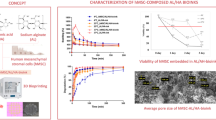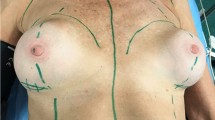Abstract
Various decellularization methods for allogenic and xenogenic bioscaffolds have been previously reported; however, decellularization methods for very thin (submillimeter-diameter) vascular tissues have not been discussed well. In this study, rat tail arteries (inner diameter, 0.6 mm) were decellularized with peracetic acid (PAA) and DNase I. PAA treatment is expected not only to disrupt cell membranes which improves the decellularization efficiency in the subsequent DNase treatment, but also to sterilize vascular scaffolds. We succeeded in adequate cell removal by immersing in 0.3% isotonic PAA solution and subsequent washing with DNase solution. For the DNase washing process, the perfusion method was superior in terms of cell removal to the static immersion method. Graft lumen was modified with a peptide composed of a collagen binding sequence and endothelial progenitor cell-binding sequence, (Pro-Hyp-Gly)7-Gly-Gly-Gly-Arg-Glu-Asp-Val, as previously reported. They were patent in rat allogeneic transplantation model for 2 weeks, but unexpectedly resulted in graft rupture or tear formation, thereafter, suggesting reduced mechanical strength of the decellularized scaffolds. Histology showed that the thickness of the extracellular matrix (ECM) was decreased by the perfusion of the DNase solution. The method of combination of PAA and DNase was not necessarily optimal for the decellularization of very thin vascular tissues. The decellularization method is a compromise between effective cell removal and maintenance of the ECM nature. Since the acceptability of ECM denaturation by the host tissue highly depends on individual cases, decellularization methods should be carefully selected according to the type of target tissue and its intended use.




Similar content being viewed by others
References
Keane TJ, Swinehart IT, Badylak SF. Methods of tissue decellularization used for preparation of biologic scaffolds and in vivo relevance. Methods. 2015;84:25–34.
Rieder E, Steinacher-Nigisch A, Weigel G. Human immune-cell response towards diverse xenogeneic and allogeneic decellularized biomaterials. Int J Surg. 2016;36:347–51.
Gilbert TW, Sellaro TL, Badylak SF. Decellularization of tissues and organs. Biomaterials. 2006;27:3675–83.
Mahara A, Somekawa S, Kobayashi N, Hirano Y, Kimura Y, Fujisato T, Yamaoka T. Tissue-engineered acellular small diameter long-bypass grafts with neointima-inducing activity. Biomaterials. 2015;58:54–62.
Yamanaka H, Yamaoka T, Mahara A, Morimoto N, Suzuki S. Tissue-engineered submillimeter-diameter vascular grafts for free flap survival in rat model. Biomaterials. 2018;179:156–63.
Munisso MC, Yamaoka T. Circulating endothelial progenitor cells in small-diameter artificial blood vessel. J Artif Organs. 2019. https://doi.org/10.1007/s10047-019-01114-6.
Malchesky PS. Peracetic acid and its application to medical instrument sterilization. Artif Organs. 1993;17:147–52.
Brown B, Lindberg K, Reing J, Stolz DB, Badylak SF. The basement membrane component of biologic scaffolds derived from extracellular matrix. Tissue Eng. 2006;12:519–26.
Schroder W. Peracetic acid disinfectant for the foodstuff industry. Brauwelt Int. 1984;1:15–20.
Freer PC, Novy FG. On the formation, decomposition and germicidal action of benzoylacetyl and diacetyl peroxides. Am Chem J. 1902;27:161–93.
Cronmiller JR, Nelson DK, Salman G, Jackson DK, Dean RS, Hsu JJ, Kim CH. Antimicrobial efficacy of endoscopic disinfection procedures: a controlled, multifactorial investigation. Gastrointest Endosc. 1999;50:152–8.
Davis BD, Dulbecco R, Eisen HN, Ginsberg HS. Microbiology including human and molecular genetics. 3rd ed. London: Harper and Row; 1980.
Baldry MGC, Fraser JAL. Disinfection with peroxygens. In: Poyne KR, editor. Industrial biocides. New York: John Wiley and Sons; 1988.
Miiller P, Raabe G, Hiirold J, Juretzek U. Action of chronic peracetic acid (Wofasteril) administration on the rabbit oral mucosa, vaginal mucosa and skin. Exp Pathol. 1988;34:223–8.
Badylak SF, Tullius R, Kokini K, Shelbourne KD, Klootwyk T, Voytik SL, Kraine MR, Simmons C. The use of xenogeneic small intestinal submucosa as a biomaterial for Achilles tendon repair in a dog model. J Biomed Mater Res. 1995;29:977–85.
Greenspan FP, MacKeller DG. The application of peracetic acid germicidal washes to mold control of tomatoes. Food Technol. 1951;6:95–7.
Yoganarasimha S, Trahan WR, Best AM, Bowlin GL, Kitten TO, Moon PC, Madurantakam PA. Peracetic acid: a practical agent for sterilizing heat-labile polymeric tissue-engineering scaffolds. Tissue Eng Part C Methods. 2014;20:714–23.
Acknowledgements
This research was supported by the Japan Agency for Medical Research and Development (AMED) S-Innovation Program for the development of bio-functional materials for the realization of innovative medicine.
Author information
Authors and Affiliations
Corresponding author
Ethics declarations
Conflict of interest
The authors declare that they have no conflict of interest.
Additional information
Publisher's Note
Springer Nature remains neutral with regard to jurisdictional claims in published maps and institutional affiliations.
Rights and permissions
About this article
Cite this article
Yamanaka, H., Morimoto, N. & Yamaoka, T. Decellularization of submillimeter-diameter vascular scaffolds using peracetic acid. J Artif Organs 23, 156–162 (2020). https://doi.org/10.1007/s10047-019-01152-0
Received:
Accepted:
Published:
Issue Date:
DOI: https://doi.org/10.1007/s10047-019-01152-0




